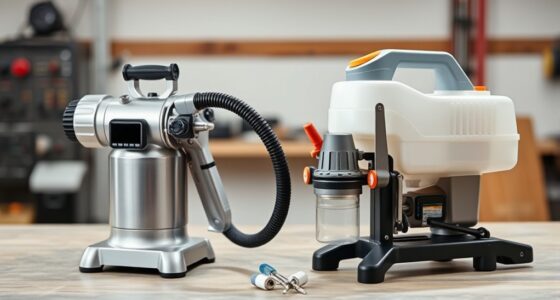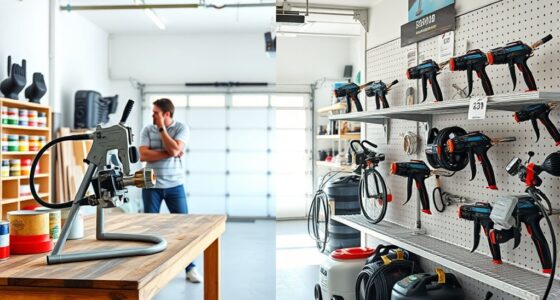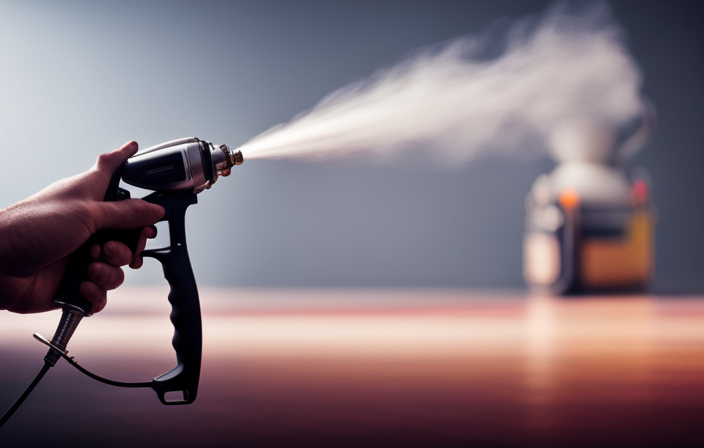Airless sprayers pump paint at high pressure, covering large areas quickly but tending to produce wider spray patterns and more overspray, making cleanup more time-consuming. HVLP sprayers operate at lower pressure with high air volume, allowing for more precise, controlled finishes with minimal overspray and easier cleanup. Your choice depends on whether you need fast coverage or fine detail work. Keep exploring to understand which sprayer suits your next project best.
Key Takeaways
- Airless sprayers pump paint at high pressure for large-area coverage, while HVLP sprayers use lower pressure with high air volume for detail.
- Airless systems produce wider spray patterns suitable for exterior surfaces; HVLP offers narrow, controlled patterns ideal for fine finishes.
- Cleanup for airless sprayers involves flushing with solvent or water, making it more time-consuming; HVLP cleanup is quicker and simpler.
- Airless sprayers provide faster application but have more overspray; HVLP sprayers offer greater control with less waste.
- Choose airless for large projects needing speed and coverage; select HVLP for detailed work requiring precision.

If you’re considering a paint sprayer for your project, understanding the differences between airless and HVLP (High Volume Low Pressure) systems is essential. Both types offer unique advantages, but they also have distinct features that influence your choice. When evaluating these sprayers, pay close attention to spray patterns and cleanup procedures, as these factors can profoundly impact your workflow and results.
Airless sprayers operate by pumping paint at very high pressure through a narrow tip, producing a fine spray that’s capable of covering large areas quickly. Their spray patterns tend to be wider and more variable, depending on the tip size and pressure settings. This makes them ideal for big projects like exterior siding, fences, or large walls, where speed and coverage are priorities. However, because of the high pressure involved, overspray can be a challenge, leading to more paint wastage and requiring careful masking. Cleanup procedures for airless sprayers can be somewhat complex. You typically need to flush the entire system with solvent or water, especially if you’re switching colors or finishes. The nozzle and hose must be cleaned thoroughly to prevent clogging and ensure consistent spray patterns during your next use. This process can be time-consuming but is necessary for maintaining top performance.
Airless sprayers deliver fast coverage but require thorough cleaning to prevent clogging and maintain performance.
On the other hand, HVLP sprayers operate at considerably lower pressure, using a high volume of air to atomize the paint. This results in more controlled spray patterns, which are narrower and more precise. Because of this, HVLP sprayers excel in fine finish work, furniture painting, or detailed projects where control over spray pattern and minimal overspray are critical. They produce less waste and overspray, making cleanup procedures simpler and faster. You usually need only to clean the spray gun and nozzle with water or solvent after use, and the overall process is less messy. This makes HVLP systems a popular choice for DIYers or projects that require a high degree of detail and fewer materials wasted.
Ultimately, your choice hinges on your project’s scope and your priorities. If you need rapid coverage over large areas and don’t mind a bit of extra cleanup, an airless sprayer might be best. Conversely, if you value precision, minimal overspray, and easier cleanup, an HVLP system will serve you better. Understanding these differences helps you select the right tool and prepares you for the spray patterns and cleanup procedures involved, ensuring a smoother painting experience.
Frequently Asked Questions
Can Airless and HVLP Sprayers Be Used Indoors Safely?
Yes, you can use airless and HVLP sprayers indoors safely if you prioritize indoor safety and proper ventilation requirements. Always guarantee the area is well-ventilated, using fans or open windows to disperse fumes and overspray. Wear appropriate protective gear, like masks and goggles, and follow manufacturer instructions. This way, you minimize health risks and create a safer environment while achieving professional-quality results indoors.
Which Sprayer Is Better for Detailed, Fine Finishes?
Think of your project as a delicate dance, and you need a partner that moves with finesse. For detailed, fine finishes, HVLP sprayers are your best choice, offering precision coating and superior finish quality. They deliver a gentle, controlled spray that’s perfect for intricate work. With HVLP, you get smooth, professional results, making your project stand out with a refined, flawless look, like a masterpiece come to life.
How Do Maintenance Routines Differ Between Airless and HVLP Units?
You need to follow different maintenance routines for airless and HVLP units. After each use, clean the spraying components thoroughly with appropriate cleaning procedures to prevent clogs and damage. Store both units in a dry, cool place, but airless sprayers often require more careful storage of hoses and filters. Regularly check for wear and tear, and follow manufacturer instructions to extend your sprayer’s lifespan.
Are There Specific Paints or Coatings Compatible With Each Sprayer Type?
Did you know that 85% of professional painters choose specific sprayers for certain coatings? With airless sprayers, you can handle thicker paints and coatings, like latex or elastomeric, without issues. HVLP sprayers are best for thinner paints, stains, and finishes. Always check the paint compatibility and coating restrictions for each sprayer type to guarantee a smooth application and avoid clogging or poor finishes.
What Is the Typical Lifespan of Each Sprayer Model?
You can expect the lifespan of an airless sprayer to be around 5 to 10 years, depending on usage and maintenance. HVLP sprayers tend to last 3 to 7 years, influenced by factors like build quality and care. Sprayer durability relies heavily on proper cleaning, regular maintenance, and following manufacturer guidelines. Longevity factors include usage frequency, the types of coatings applied, and storage conditions, all vital for extending your sprayer’s life.
Conclusion
Ultimately, choosing between airless and HVLP sprayers depends on your project needs. Many believe HVLP sprayers always provide a better finish, but that’s not entirely true. In fact, research shows that airless sprayers can deliver a smoother coat on larger surfaces without sacrificing quality. So, don’t assume one is always better—consider your specific project, spray distance, and material. Testing both options might reveal that the best choice varies based on what you’re working on.









